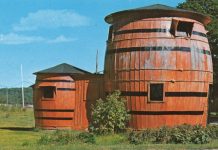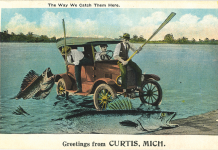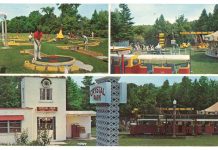If Gulliver had traveled the U.S., he would have found miniature villages scattered across the states, and Michigan was no exception. The largest and most impressive of Michigan’s tiny towns was the miniature city at Clinch Park in Traverse City.
Con Foster, a retired circus man and local Traverse City promoter, thought the idea of a miniature city would be an added attraction to Clinch Park, as well as put city employees to work. In 1931, with funds from the Works Progress Administration (WPA), city workers constructed scale models of Traverse City buildings, including the Park Place Hotel, St. Francis Church, Pere Marquette Railroad Station and others. The village featured over 100 buildings. Although barely waist high, every detail of construction was carefully executed, including color schemes, rooflines, windows and doors.

Where possible, the original blueprints were used. Such attention to detail was carried out even as stores in the downtown area were remodeled; their miniature counterpoints also were updated. Paved streets bisected the tiny town, a river wended through and a mechanically operated train ran on miniature tracks. The landscape of lawns and Japanese dwarf trees and shrubs was carefully nursed.
To make room for a parking lot, the village was moved in 1954 to another section of Clinch Park. City workers cared for the village for over 40 years and painstakingly took down the exhibit each fall and put it back up each spring. Vandalism and weather ultimately took their toll, and in 1973 the city decided they could no longer maintain the tiny town, and the buildings were put in storage.
Con Foster, a retired circus man and local Traverse City promoter, thought the idea of a miniature city would be an added attraction to Clinch Park, as well as put city employees to work.
In 1991, most of the buildings were donated to the Music House Museum with the condition that they be restored and displayed for the public. Only a few were salvageable and local volunteer modelers and miniaturists recreated the 21 buildings that are now on display at the Music House. A 1961 editorial in the Traverse City Record-Eagle pronounced that “Clinch Park … and the miniature village are remembered more vividly by visitors than any other local feature.”
Little Netherlands recreated a canal-side Dutch village and farm country of the Old World in miniature. It also was built as a WPA project and constructed by local craftsmen. Opening in 1938 as part of the Tulip Time Festival, it was located at the corner of Central Avenue and 12th Street in downtown Holland. Built to a scale of 1 inch to 1 foot, the village included town scenes, cottages, canals, boats, dikes, windmills, animals, trees and, of course, tulips. Over 100 figures were sculpted in detail with authentic style and coloring of dress. In 1966, Little Netherlands was moved to Windmill Island.

Another Lilliputian Village was built by J.D. Locey in the center of Vanderbilt in the mid-1930s. The small northern Michigan village covered a plot about 20-by-35 feet and featured houses, flowerbeds, bridges and pools. The masterpiece was an electrically lighted cobblestone house that stood about 20 inches high.
In the 1940s and 1950s, Kalkaska got into the act with its own miniature village in the front yard of George H. Kilpatrick’s home. Located at the north end of Kalkaska Village on U.S. 131, Kilpatrick, an apiarist, sold his honey and invited visitors to see his tiny town, which featured scaled models of Independence Hall, Mount Vernon, Abraham Lincoln’s log home, the Christian Science Church of Boston, the Ford Theater, as well as businesses, churches and houses. A Kalkaska postcard message from 1953 reads, “On my way to camp from the lake I stopped at this place to buy some creamed honey.”

Detroit’s Midget City was a tourist attraction built by Orrin (Heine) Dorworth in 1939. It was located just off Plymouth Road near Telegraph on Detroit’s far west side. The tiny town, enclosed with a fence, featured a miniature replica of Thomas Edison’s birthplace, as well as Benjamin Franklin’s birthplace. A business district, farm, hospital, town hall, hotel, Native American village, old mill and coal mine also were represented with diminutive automobiles and a model train traversing the display. Although admission was only 10 cents, Midget City was closed by the end of World War II because of a lack of manpower to run the attraction and tourists to visit it.
BLUE Vintage Views columnists M. Christine Byron and Thomas R. Wilson reside in Grand Rapids. They are authors of the book “Vintage Views Along Scenic M-22 including Sleeping Bear Dunes.”








Facebook Comments